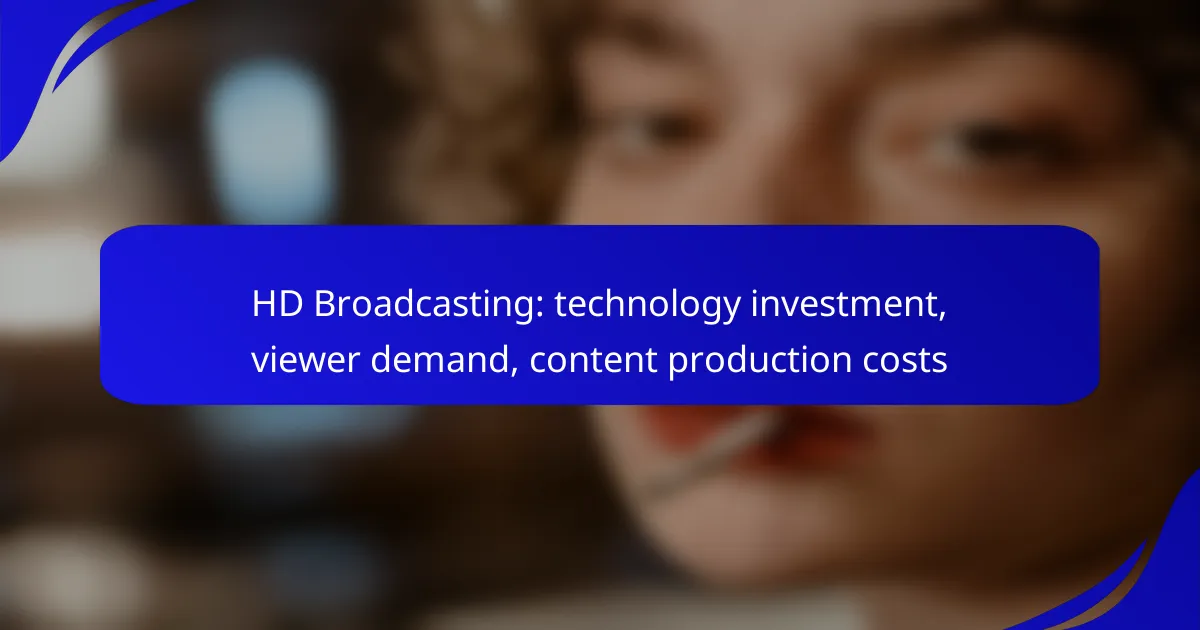The landscape of HD broadcasting is rapidly evolving, driven by a surge in viewer demand for high-quality content. This shift compels broadcasters to invest in advanced technology, upgrade equipment, and explore innovative partnerships, all while navigating the significant costs associated with content production. As audiences increasingly gravitate towards high-definition offerings, understanding the interplay between investment, viewer expectations, and production expenses becomes essential for success in this competitive market.

What are the investment opportunities in HD broadcasting technology?
Investment opportunities in HD broadcasting technology are expanding due to increasing viewer demand for high-quality content. Companies can focus on upgrading equipment, exploring cloud solutions, and forming partnerships with streaming services to enhance their offerings.
Investment in 4K and 8K broadcasting equipment
Investing in 4K and 8K broadcasting equipment is essential for staying competitive in the HD market. These technologies offer superior resolution, attracting viewers who prefer high-definition content. Companies should consider the costs associated with cameras, transmission systems, and display technologies, which can range from thousands to millions of USD depending on the scale of the operation.
When upgrading, it’s crucial to assess compatibility with existing infrastructure and the potential return on investment. Investing in scalable solutions can help manage costs while meeting future demands.
Funding for cloud-based broadcasting solutions
Cloud-based broadcasting solutions provide flexibility and scalability, making them an attractive investment. These platforms allow for efficient content delivery and storage, reducing the need for extensive on-premises hardware. Funding options may include venture capital, partnerships, or government grants, particularly in regions promoting digital innovation.
Companies should evaluate different cloud providers based on their service offerings, reliability, and pricing models. A hybrid approach, combining cloud and traditional broadcasting, can often yield the best results.
Partnerships with streaming platforms like Netflix
Forming partnerships with streaming platforms like Netflix can significantly enhance content distribution and viewer reach. These collaborations can provide access to a larger audience and shared resources for content production. Companies should negotiate terms that allow for revenue sharing and co-production opportunities.
It’s essential to align content strategies with the streaming service’s audience preferences, ensuring that investments in HD broadcasting yield maximum visibility and engagement. Regularly reviewing partnership performance can help in making necessary adjustments to content offerings.
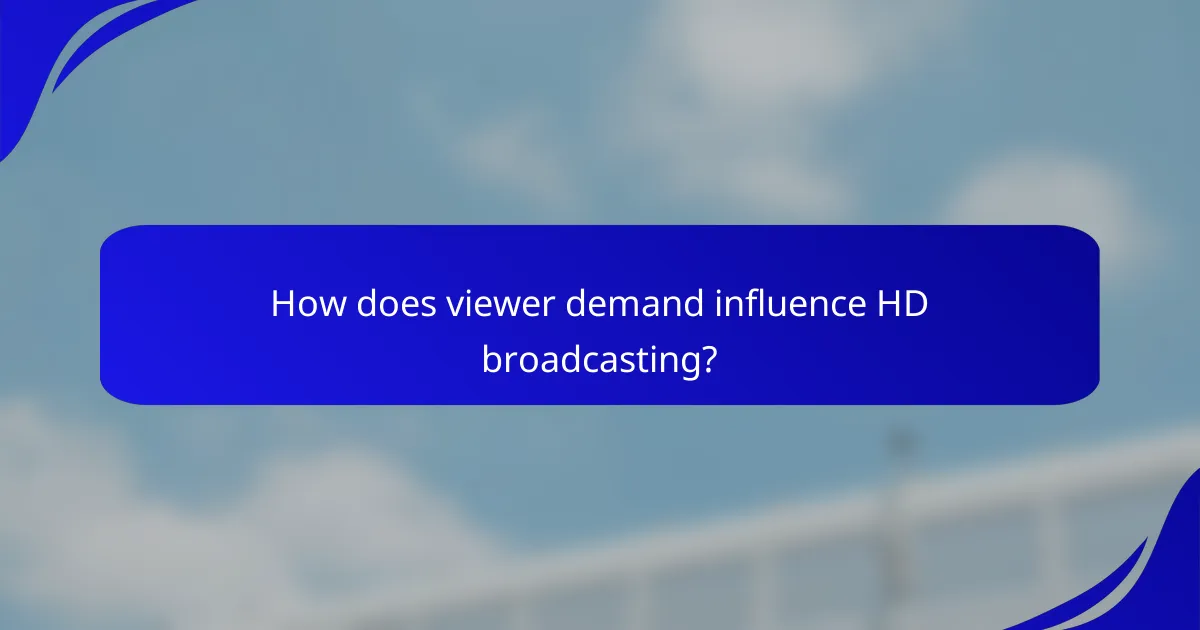
How does viewer demand influence HD broadcasting?
Viewer demand significantly shapes HD broadcasting by driving investments in technology and influencing content production strategies. As audiences increasingly prefer high-definition content, broadcasters must adapt to meet these expectations, which in turn affects their operational costs and technological advancements.
Increase in consumer preference for high-definition content
Consumers are increasingly favoring high-definition (HD) content, which has led to a surge in demand for HD broadcasting. This preference is evident across various platforms, including cable, streaming services, and digital broadcasts, where viewers expect sharper images and better sound quality.
To capitalize on this trend, broadcasters are investing in advanced transmission technologies and upgrading their production facilities. For example, many networks are transitioning to 4K and even 8K formats to stay competitive, which can involve significant costs but is often justified by the potential for increased viewership and advertising revenue.
Impact of mobile streaming on viewing habits
The rise of mobile streaming has transformed viewing habits, with many consumers now watching content on smartphones and tablets. This shift has heightened the demand for HD broadcasting, as viewers expect high-quality visuals even on smaller screens.
Broadcasters must consider optimizing their content for mobile devices, ensuring that HD streams are accessible without excessive buffering or data usage. This may involve adopting adaptive bitrate streaming technologies, which adjust video quality based on the viewer’s internet speed, thus enhancing the overall viewing experience.

What are the costs associated with content production in HD broadcasting?
The costs of content production in HD broadcasting can be significant, encompassing various elements such as equipment, software, and personnel. Understanding these expenses is crucial for budgeting and ensuring high-quality output.
Budget for high-quality camera equipment
Investing in high-quality camera equipment is essential for producing HD content. Professional cameras can range from several thousand to tens of thousands of dollars, depending on the brand and specifications. It’s important to consider not only the initial purchase but also ongoing maintenance and potential upgrades.
When budgeting, factor in additional accessories like lenses, tripods, and lighting equipment, which can add to the overall cost. Renting equipment can be a cost-effective alternative for smaller productions or specific projects.
Expenses related to post-production editing software
Post-production editing software is a critical component of HD broadcasting, with costs varying widely based on the software’s capabilities. Popular options like Adobe Premiere Pro or Final Cut Pro can cost anywhere from a few hundred to over a thousand dollars for licenses or subscriptions.
Consider the need for additional plugins or tools that enhance editing capabilities, which can further increase expenses. Investing in training for staff to effectively use these tools can also be a significant but necessary cost.
Costs of hiring specialized production crews
Hiring specialized production crews is often necessary to achieve professional-quality HD broadcasts. Crew costs can vary based on experience, location, and the complexity of the project, typically ranging from hundreds to thousands of dollars per day.
When planning your budget, account for the various roles needed, such as directors, camera operators, and sound technicians. It’s beneficial to hire experienced professionals who can deliver high-quality results, as this can save time and reduce the need for extensive rework.
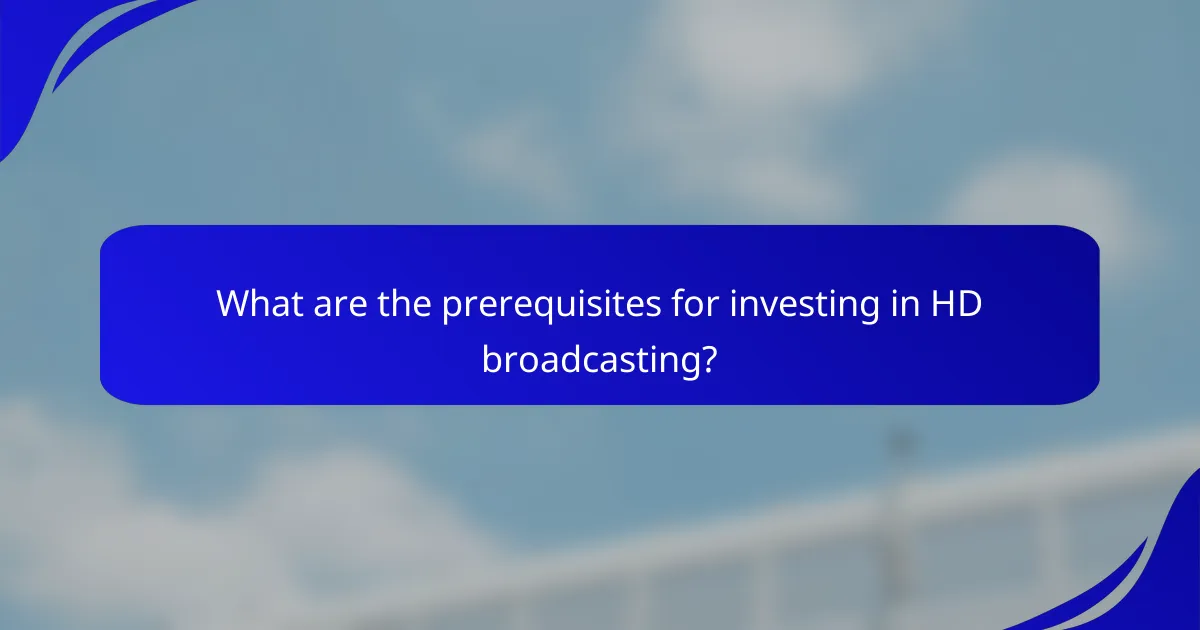
What are the prerequisites for investing in HD broadcasting?
Investing in HD broadcasting requires a thorough understanding of regulatory frameworks, market dynamics, and production costs. Key considerations include compliance with local regulations, assessing competition, and evaluating the financial implications of high-quality content production.
Understanding regulatory requirements in Canada
In Canada, broadcasters must adhere to the Canadian Radio-television and Telecommunications Commission (CRTC) regulations. These regulations cover licensing, content standards, and technical specifications for HD broadcasting. Familiarity with these requirements is essential for any investor looking to enter the market.
Additionally, compliance with the Broadcasting Act is crucial, as it outlines the obligations of broadcasters regarding Canadian content and accessibility. Investors should ensure that their operations align with these regulations to avoid penalties and maintain their broadcasting licenses.
Assessing market competition in the Canadian broadcasting landscape
The Canadian broadcasting landscape is competitive, with several established players in the HD market. Investors should analyze the market share of existing broadcasters, their content offerings, and pricing strategies. Understanding the competitive landscape can help identify potential gaps and opportunities for new entrants.
Market research can reveal viewer preferences and trends, which are critical for tailoring content to meet audience demand. Engaging with industry reports and consumer surveys can provide valuable insights into the competitive dynamics and help shape investment strategies effectively.
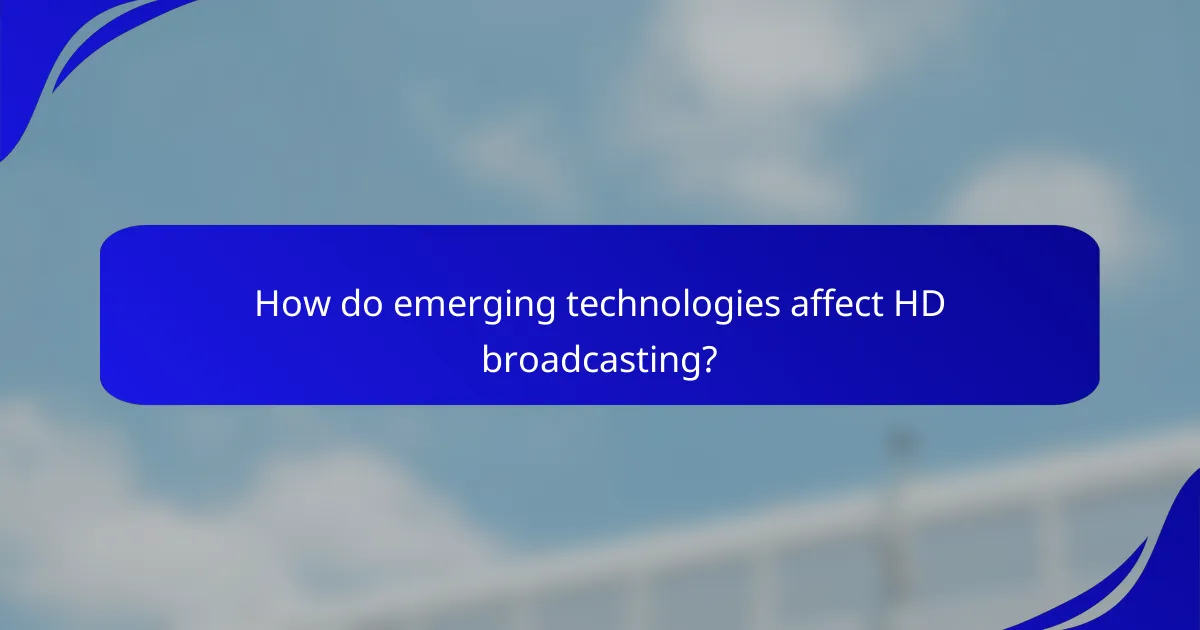
How do emerging technologies affect HD broadcasting?
Emerging technologies significantly enhance HD broadcasting by improving content creation, distribution, and viewer experience. Innovations like artificial intelligence and 5G networks are reshaping how content is produced and delivered, meeting growing viewer demand for high-quality streaming.
Role of AI in content creation and distribution
Artificial intelligence is transforming content creation and distribution in HD broadcasting by automating processes and personalizing viewer experiences. AI algorithms can analyze viewer preferences, enabling broadcasters to tailor content recommendations effectively.
Additionally, AI tools can streamline production workflows, reducing costs and time associated with content creation. For instance, AI-driven editing software can assist in video editing, allowing creators to focus on storytelling rather than technical details.
Impact of 5G technology on streaming quality
5G technology enhances streaming quality for HD broadcasting by providing faster data transfer rates and lower latency. This allows for smoother playback and higher resolution content, which is crucial for an immersive viewing experience.
With 5G, broadcasters can offer live events in real-time with minimal buffering, catering to the increasing demand for high-quality streaming. As 5G networks expand, viewers can expect more reliable access to HD content across various devices, from smartphones to smart TVs.
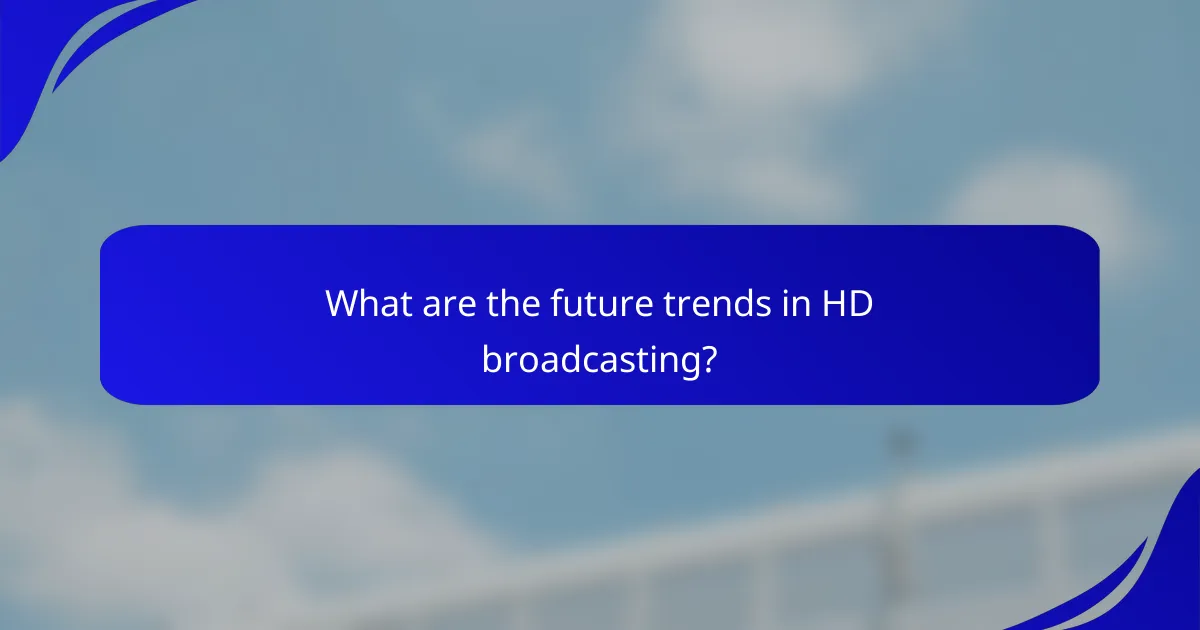
What are the future trends in HD broadcasting?
The future of HD broadcasting is shaped by advancements in technology, evolving viewer preferences, and increasing production costs. Key trends include the rise of immersive content formats and a focus on tailored viewing experiences that cater to individual audience needs.
Growth of virtual reality content in broadcasting
Virtual reality (VR) content is gaining traction in HD broadcasting, providing viewers with immersive experiences that traditional formats cannot match. This technology allows audiences to engage with content in a three-dimensional space, enhancing storytelling and viewer interaction.
As VR technology becomes more accessible and affordable, broadcasters are investing in VR production capabilities. This shift requires not only new equipment but also a rethinking of content creation strategies to fully leverage the immersive potential of VR.
Shift towards personalized viewer experiences
Personalized viewer experiences are becoming a priority in HD broadcasting, driven by advancements in data analytics and machine learning. Broadcasters are utilizing viewer data to tailor content recommendations, ensuring that audiences receive programming that aligns with their preferences.
This trend necessitates a balance between content variety and personalization. Broadcasters should consider implementing algorithms that analyze viewing habits while maintaining a diverse library to attract a broader audience. Engaging viewers through interactive features can further enhance the personalized experience.
